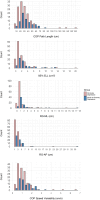Directional postural sway tendencies and static balance among community-dwelling older adults with depression and without cognitive impairment
- PMID: 40839173
- PMCID: PMC12370788
- DOI: 10.1007/s40520-025-03144-y
Directional postural sway tendencies and static balance among community-dwelling older adults with depression and without cognitive impairment
Abstract
Background: Depression is prevalent among older adults and is known to negatively affect balance, ultimately leading to falls. However, few studies have investigated the effect of depression on static balance metrics beyond postural sway distance and area of older adults without mild cognitive impairment (MCI).
Aims: To investigate if postural sway distance, sway area, medial-lateral (ML) sway range, anterior-posterior (AP) sway range, and center-of-pressure (COP) sway speed variability differed between non-cognitively impaired older adults with minimal-to-no depression (Minimally Depressive group) and mild-to-severe depression (Mildly-to-Severely Depressive group).
Methods: A total of 204 community-dwelling older adults were included. Depression was measured using the Patient Health Questionnaire-9 (PHQ-9), MCI using the Rowland Universal Dementia Assessment Scale (RUDAS), and static balance metrics using the Balance Tracking System (BTrackS). Mann-Whitney U tests determined differences between groups.
Results: Sway area, AP sway range, and ML sway range were significantly greater in the Mildly-to-Severely Depressive group than the Minimally Depressive group (p = 0.010, p = 0.016, and p = 0.031, respectively). Sway distance (p = 0.445) and COP sway speed variability (p = 0.193) were not significantly different between groups.
Discussion: The findings revealed greater sway area, as well as greater ranges in the AP and ML directions, in the Mildly-to-Severely Depressive group when compared to the Minimally Depressive Group. Reduced concentration and affected postural stabilization mechanisms driven by depression may have attributed to these results.
Conclusions: This study highlights the need for further understanding of how static balance metrics, such as directional sway, are affected by depression, thereby creating interventions tailored to individual's postural sway characteristics to help reduce fall risk and improve balance.
Trial registration: ClinicalTrials.gov (NCT05778604).
Keywords: BTrackS; Balance; Ellipse area; Mental health.
© 2025. The Author(s).
Conflict of interest statement
Declarations. Ethical approval: This study adhered to the principles of the Declaration of Helsinki and has been approved by the University of Central Florida Institutional Review Board (STUDY00003206). All data was deidentified on the REDCap platform. All research procedures were performed with strict adherence to the protection of participants’ confidentiality and rights. Conflict of interest: JP, NRL, and LT received financial support from the National Institute on Minority Health and Health Disparities of the National Institutes of Health under award R01MD018025. JRMS received financial support from the Office of the Director, Chief Officer for Scientific Workforce Diversity of the National Institutes of Health under award number 3R01MD018025-02S1.
Figures
References
-
- Burton C, McKinstry B, Szentagotai Tătar A et al (2013) Activity monitoring in patients with depression: a systematic review. J Affect Disord 145(1):21–28. 10.1016/j.jad.2012.07.001 - PubMed
-
- Schuch F, Vancampfort D, Firth J et al (2017) Physical activity and sedentary behavior in people with major depressive disorder: A systematic review and meta-analysis. J Affect Disord 210:139–150. 10.1016/j.jad.2016.10.050 - PubMed
-
- Snowdon J (2001) Is depression more prevalent in old age? Aust N Z J Psychiatry 35(6):782–787. 10.1046/j.1440-1614.2001.00968.x - PubMed
Publication types
MeSH terms
Associated data
Grants and funding
LinkOut - more resources
Full Text Sources
Medical



